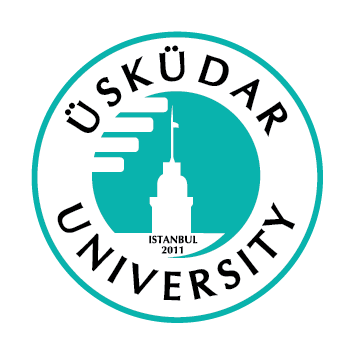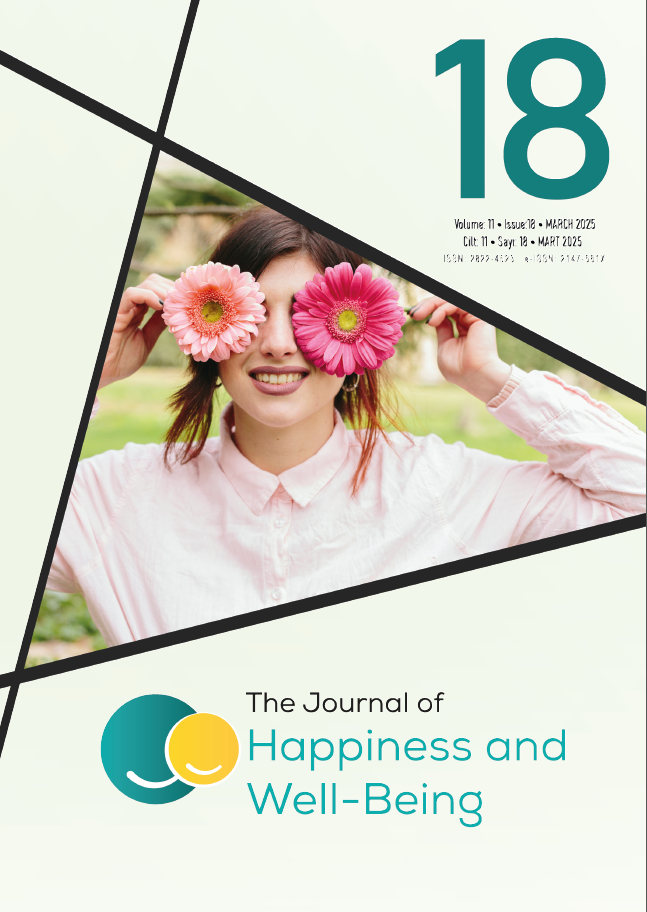Author Guidelines
The Journal of Happiness and Well-Being (JHWB) uses the in-text citation method of version 7.0 of the American Psychological Association Rules (APA).
JHWB is published according to the following spelling rules:
Principles Regarding Page Layout and Spelling Rules
* The page layout of the articles should be normal, the page structure should be 2.5 cm from the top, bottom, left and right edges, the gutter should be 0, the header should be 1.25 cm, and the footer should be 1.25 cm.
* All article texts should be written in Times New Roman, 12 font size and 1.5 line spacing, justified on both sides of the page; paragraph indent should be designed as 1.25 cm. One line space must be left before headings in the text.
* The title of the article (main title) should be written in 14 pt, capital letters, bold and centered on the page. Sub-headings should be bold, 12-point, left-justified, and the initials of the words in the title should be written in capitals and the other letters in lower-case. The title should be short and relevant to the topic. The title must not exceed 12 words in the language in which the article was published.
* Line spacing should be 1.5 and 0 pt, except for the bibliography, and 1 and 0 pt in the bibliography.
* Page numbers should be given at the bottom and on the right.
* Although the language of the journal is Turkish, studies written in English can also be published. The conformity of the articles sent to the journal to the grammar rules is made by the language editors. The grammar and abbreviation rules of Turkish articles are based on the Spelling Guide of the Turkish Language Institution.
* In articles written in Turkish, the Turkish abstract is written before the introduction part of the article, followed by the English abstract. In the articles written in English, the English abstract should be included before the introduction part of the article, followed by the Turkish abstract.
* The length of the articles should not exceed 30 pages including the abstract and references.
*The Turkish/English article titles, abstract, five keywords, which form the part before the introduction of each article, must not exceed 400 words in total.
* The name and surname of the author(s) should be placed under the main title of the article, centered on the main title, and the surname should be written in capital letters. The information about the author (institutional information, contact information and Orcid numbers) should be written as footnotes, with an upper star * at the end of the surname, in Times New Roman, justified on both sides of the page and visible only on the first page, in 10 font size with 1 space.
* In Abstract/Abstract titles, the first letter should be capitalized, left justified, 12 point and plain/bold font. Abstract/Abstract texts and Keywords/Key Words should be written in plain font, 11 font size and 1.5 line spacing.
*Expressions such as newspapers, books, magazines, works of art, computer games, mobile applications and brand names in the text must be written in italics.
* The text of the bibliography should be written in 10 font size and single line spacing. If the bibliography is longer than one line, the next line(s) should be indented 1.25 cm. In cases where more than one work by the same author is used, a solid line is used instead of the author's name in the repetitions after the first work.
* Figures and tables should be placed in the text.
* In accordance with COPE principles and academic study criteria, ethics committee approval should be obtained depending on the study area and should be specified in the study in detail.
*The Turnitin/iThenticate similarity report must be below 25% in order for the article to be considered. Articles with a similarity rate exceeding 25% are not included in the evaluation process.
Principles Regarding References and Submissions
The Journal of Happiness and Well-Being (JHWB) uses the in-text citation method of version 7.0 of the American Psychological Association Rules (APA).
* In the bibliography, the sources cited and referenced in the text should be included completely.
* According to the rules of APA 7.0, the bibliography is created in alphabetical order according to the surnames of the first authors of the works.
* If there is more than one work by the same author in the bibliography, the works are sorted by considering the publication dates. If more than one work published in the same year is included in the bibliography, the works should be listed in the form of letters (a, b, c, …) in the order of their citation in the article.
* The latest version of the APA is taken into account when citing the works that are not included in the citation styles mentioned below.
Books
1. Single-authored books:
In-text: (Tarhan, 2012, p.35)
Bibliyography:
Tarhan, N. (2012). Mesnevi Therapy. Timas Publications.
2. Books with two or more authors:
In-text: (Arıboğan et al., 2008, p. 66)
Bibliyography:
Arıboğan, D.Ü., Ortaylı, İ. and Yavuz, H. (2008). about our republic. Asiyan Publishing House.
3. Books without an author or editor name:
In-text: (Turkish science terms dictionary, 2011, p. 1157)
Bibliyography:
Dictionary of Turkish science terms: Social sciences. (2011). Academy Bookstore.
4.Book chapters:
In-text: (Ergüzel & Tarhan, 2017)
Bibliyography:
Ergüzel, T.T and Tarhan, N. (2017). Machine learning approaches to predict repetitive transcranial magnetic stimulation treatment response in major depressive disorder (Ed.), in Proceedings of SAI intelligent systems conference (p. 57-78). springer https://dx.doi.org/10.1007/978-0-387-76483-2_6
5. Works with an editor or translator together with the author:
In-text: (Arasteh, 1965/2000, p. 55)
Bibliyography:
Arasteh, A. R. (2000). Rebirth in love and creativity: Mevlana Celaleddin Rumi's personality analysis (Trans. Demirkol, B. ve Özdemir, İ.). Book Publications. (Original published 1965)
In-text: (Balsam et al., 2019)
Bibliyography:
Balsam, K. F., Martell, C. R., Jones, K. P., & Safren, S. A. (2019). Affirmative cognitive behavior therapy with sexual and gender minority people. G. Y. Iwamasa & P. A Hays (Eds.), Culturally responsive cognitive behavior therapy: Practice and supervision içinde (İkinci basım., s. 287-314). American Psychological Association. https://doi.org/ 10.1037/0000119-012.
Articles
1. Single-author articles
In-text: (Tarhan, 2001)
Bibliyography:
Tarhan, N. (2001). Loneliness and social dissatisfaction in turkish adolescents. The Journal of Psychology, 135(1), 113-123. https://doi.org/10.1080/00223980109603684
2. Articles with two to six authors
In-text: (Arasil et al., 2020)
Bibliyography:
Arasil, A. B. S., Turan, F., Metin, B., Ertaş, H. S., & Tarhan, N. (2020). Positive psychology course: A way to improve well-being. Journal of Education and Future, 17, 15-23. https://doi.org/10.30786/jef.591777
3. Articles with six to twenty authors
In-text: (Metin et al., 2018)
Bibliyography:
Metin, S. Z., Erguzel, T. T., Ertan, G., Salcini, C., Kocarslan, B., Cebi, M., Metin, B., Tanridag, O., & Tarhan, N. (2018). The use of quantitative EEG for differentiating frontotemporal dementia from late-onset bipolar disorder. Clinical EEG and Neuroscience, 49(3), 171-176. https://doi.org/10.1177/1550059417750914
4. Articles with more than twenty authors
In-text: (Kalnay et al., 1996)
Bibliyography:
Kalnay, E., Kanamitsu, M., Kistler, R., Collins, W., Deaven, D., Gandin, L., Iredell, M., Saha, S., White, G., Woolen, J., Zhu, Y., Chelliah, M., Ebisuzaki, W., Higgins, W., Janowiak, J., Mo, K.C., Ropelewski, C., Wang, J., Leetmaa, A., … Joseph, D. ( 1996). The NCEP/NCAR 40-year reanalysis project. Bulletin of the American Meteorological Society, 77(3), 437-471. http://doi.org/fg6rf9
5. Article in online journal:
In-text: (O'Toole, Mulhall and Eppich, 2022)
Bibliyography:
O'Toole, M., Mulhall, C., & Eppich, W. (2022). Breaking down barriers to help-seeking: preparing first responders' families for psychological first aid. European Journal of Psychotraumatology, 13(1), Advance online publication https://doi.org/10.1080/20008198.2022.2065430
PhD and Master's theses
In-text: (Çetinkaya, 2015)
Bibliyography:
Cetinkaya, S. (2015). Stochastic mortality using non-life methods [Unpublished doctoral dissertation]. Dogus University.
Reports
In-text: (Çanak et al., 2014)
Bibliyography:
Akbaytürk Çanak, T., Çelik, S., Çetinkaya, İ., Çukadar, S., Güneş, G., Gürdal, G., Holt, İ., Kaya, E., and Kaygusuz, A. (2014). University libraries in Turkey towards 2023: Current situation, problems, standards and solutions. Council of Higher Education. https://kutuphane.adu.edu.tr/webfolders/files/20201211154726-J727BD80D65HFPOZ2LU3-GULBOZKURT-393836483.pdf
Encyclopedia
In-text: (Keyormarsi, O'Leary and Pardee, 2020: 200)
Bibliyography:
Keyormarsi, K., O'Leary, N., & Pardee, A. B. (2020). cell division. McGraw-Hill Education. https://doi.org/10.1036/1097-8542.116300
Recorded or Archived Interview
In-text: (Sabbatini, 1993)
Bibliyography:
Sabbatini, G. (1993, September 10). Musical performance of Giuseppe Sabbatini [Interview]. Studs Terkel Radio Archive; The Chicago History Museum. https://studsterkel.wfmt.com/programs/musical-performance-giuseppe-sabbatini?t=NaN%2CNaN&a=%2C
E-Book
In-text: (Christian & Griffiths, 2016)
Bibliyography:
Christian, B., & Griffiths, T. (2016). Algorithms to live by: The computer scienee of human decisions. Henry Holt and Co. http://a.eo/7qGBZAk
Social media
In-text: (National Geographic, 2020)
Bibliyography:
National Geographic [@NatGeo]. (2020, January 12). Scientists knew African grays are clever, but now they've been documented assisting other members of their species—even strangers. [Tweet]. Twitter https://twitter.com/NatGeo/status/1216346352063537154


